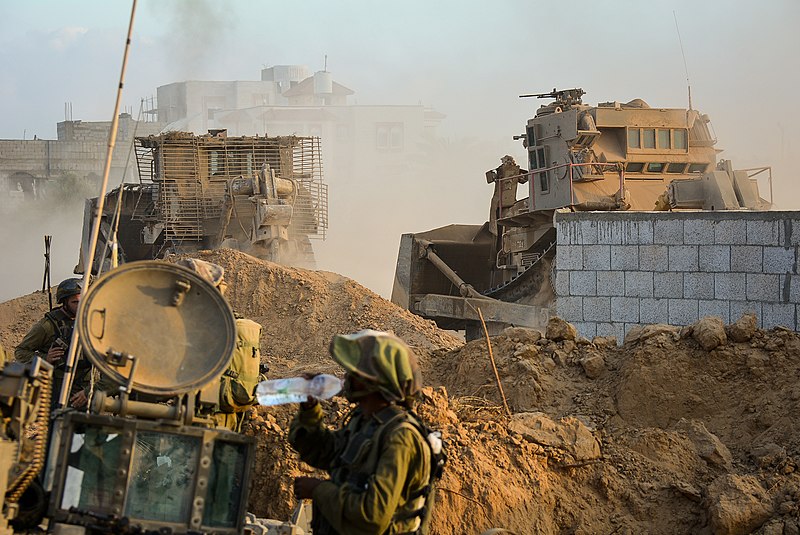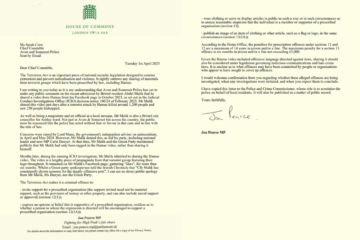The conflict in Gaza between Israel and the Hamas terror group will on Sunday reach one hundred days since the 7 October attacks.
On the ground:
- Israel’s leadership has indicated a shift in its military campaign against Hamas, moving from intense battles to more targeted operations. Both defence minister Yoav Gallant and IDF spokesman Daniel Hagari have publicly noted that different tactics will be needed to avoid civilian casualties in southern Gaza.
- The shift, which involves fewer ground troops and airstrikes, will also see a reduction in the number of Israeli troops in Gaza, a process which began with the new year.
- Hagari also indicated a shift from the “intense manoeuvring phase of the war” to “different types of special operations” that would “take into consideration the huge number of civilians”.
- The IDF has largely defeated Hamas in northern Gaza, which was the scene of most intensive fighting in the first months of the conflict. Since December, the focus of the conflict has moved to the Strip’s centre and south, in areas like Khan Younis and Rafah.
- Hamas continues to indiscriminately fire rockets into Israel from Gaza, with more than 10,000 fired since 7 October.
- Latest figures suggest that at least 1,398 Israelis have been killed since 7 October, including in the initial Hamas terror attacks, rocket attacks, and subsequent war in Gaza. At least 134 Israelis are thought to still be being held hostage by Hamas.
- Since 7 October, some 23,210 Palestinians have reportedly been killed according to figures provided by Gaza’s health ministry, which is run by Hamas. These figures have not been independently verified and make no distinction between civilians and Hamas fighters, of which there were reportedly around 40,000 in the Gaza Strip prior to the conflict. The IDF claims to have killed over 8,500 Hamas operatives in Gaza, alongside the 1,000 who were killed inside Israel on 7 October.
- Since operations began, Israel’s air force has struck thousands of Hamas targets in the Gaza Strip, including rocket systems, command centres, strategic infrastructure sites, and underground targets.
Hostages:
- Some 134 hostages are believed to still be being held in Gaza, including it was confirmed this week two British nationals.
- On 10 January, Israel’s war cabinet on Wednesday reviewed a new Qatari proposal for a hostage release deal and ceasefire in the Gaza Strip, according to multiple reports. The offer was said to go beyond a temporary truce, providing a roadmap for ending the war that includes Hamas’s leaders going into exile and Israel withdrawing its troops from the Strip.
Humanitarian situation:
- Latest statistics indicate that some 137,920 tons of humanitarian aid has entered Gaza since 7 October in 7,652 trucks. This has included supplies of food, water, medical equipment, shelter supplies, and other mixed aid.
Humanitarian aid
- Following initial restrictions on the movement of goods into Gaza after 7 October, aid has flowed since 22 October, primarily through the Rafah crossing with Egypt. The Israeli Kerem Shalom border crossing is also now open and functional.
- Humanitarian aid is routed to Egypt and then forwarded to undergo Israeli security screening at either Nitzana or Kerem Shalom Crossings. From there, UN aid is sent to the Gaza Strip via Kerem Shalom, and the rest is sent to Gaza via the Rafah crossing in Egypt. The volume of humanitarian aid is determined, among other factors, by the ability of humanitarian organizations within the Gaza Strip to absorb the aid.
- Field hospitals donated by Jordan and the UAE are operational in Khan Younis and Rafah, while a Red Crescent field hospital at the Al Amal Hospital and an IMC field hospital are treating patients in Khan Younis and Rafah, respectively. Some 28,000+ people have been treated at the field hospitals so far. France and Italy have established floating hospitals at the Al-Arish port, having treated some 1,560 patients.
- Some 1,603 ill and wounded people, alongside escorts, have been able to leave Gaza in order to receive medical treatment in Egypt, the UAE, Turkey, Qatar and Jordan.
Infrastructure
- 90% of drinking water in Gaza is self-sourced. Before 7 October, only 10% came from Israel. Following damage by Hamas on 7 October, two water pipes to southern Gaza – Birkat Sa’id and Bani Suheila – have been reopened since the conflict began and are providing water at a rate pf 28.5m litres per day.
- Israel has also coordinated refuelling and repairing of UNRWA water wells, three pumps at a UNICEF desalination plant in Deir-Albalah and implementing two water pipelines from desalination facilities in Egypt.
- Daily imports of diesel fuel and cooking gas have been entering through the Rafah crossing via an Israeli-US-Egypt-UN deal.
Humanitarian corridors and pauses
- Between 5 November – 4 January, Israel declared a daily evacuation corridor along the Salah A-Din road in Gaza, allowing over 350,000 people to evacuate from northern to southern Gaza for their safety.
- Since 4 January, the daily evacuation corridor has been rerouted to A-Rashid Road, allowing for passage from northern to southern Gaza and for the movements of coordinated humanitarian aid truck convoys to northern Gaza.
- The IDF has also been conducting unilateral humanitarian pauses in localities such as Rafah and Deir al-Balah, typically for four hours at a time, to allow civilians to replenish supplies of food and water.
Future of Gaza:
- On 10 January, Netanyahu released a recorded statement insisting that Israel “has no intention of permanently occupying Gaza or displacing its civilian population”. He continued: “Our goal is to rid Gaza of Hamas terrorists and free our hostages. Once this is achieved, Gaza can be demilitarized and deradicalized, thereby creating a possibility for a better future for Israel and Palestinians alike”.
- Israeli officials have repeatedly indicated that Israel would likely maintain “security responsibility” in Gaza after Hamas had been removed from power. This was supported by Netanyahu in an interview on 6 November. This echoes the arrangement, as mutually agreed in the Oslo Accords, for much of the West Bank, where there is a split between civil responsibility and security responsibility in different areas. The Biden administration has indicated its agreement with Israel’s assessment, while opposing any permanent reoccupation of Gaza.
- On 5 December, Netanyahu reiterated that Israel believes that Gaza will have to be demilitarised after the current war and cast doubt on the ability of international forces to implement this, pointing to the failure of UNIFIL in southern Lebanon since 2006. Israel has reportedly told a number of Middle Eastern countries that it plans to create a “buffer zone between Gaza and Israel” to prevent future terror attacks following the current war.
- Speaking after meetings with leaders around the Middle East, US secretary of state Anthony Blinken has reiterated the Biden administration’s view that a “regional approach that includes the pathway to a Palestinian state” was the way to reach a “lasting solution that ends the long-running cycle of violence”. This, he said, must include “a commitment to take the steps necessary to give Israel confidence in its security” from Arab states such as Saudi Arabia and Qatar.
Domestic Israeli politics:
- A “national emergency government” was formed in Israel soon after 7 October, with leading opposition figure Benny Gantz entering into a coalition with prime minister Benjamin Netanyahu. The coalition agreement has seen Netanyahu’s hard right coalition partners – Itamar Ben Gvir and Bezalel Smotrich – sidelined and excluded from the war cabinet.
- Polling in Israel suggests that Netanyahu’s Likud and its right-wing coalition partners would be trounced were an election held today, with centrist Benny Gantz seeing a surge of support. Polling since 7 October has consistently indicated that the opposition bloc would win a majority of up to 14 seats in Israel’s 120-seat Knesset in an election.
Situation in the West Bank:
- The West Bank has seen a dramatic increase in tensions and violence since 7 October, with the IDF arresting more than 4,700 Palestinians, many of whom are affiliated with Hamas and other terror groups. Some 340 Palestinians, many of them associated with Hamas, have died in the West Bank since 7 October.
- A series of terror attacks and attempted attacks have also taken place in the West Bank and East Jerusalem since 7 October, including a shooting attack by three Palestinians which killed a Palestinian man and injured another woman on 8 January.
- Israel has been conducting raids to arrest suspected terrorists in a number of locations in the West Bank, including Jenin, Nablus and Tulkarem, which have become flashpoints for confrontation between Palestinians and the IDF. Analysis suggests that the majority of Palestinian deaths in the West Bank have taken place during arrest raids, and around 60 percent of people killed have been armed.
- In November, Netanyahu criticised a “tiny handful of extremists” in the West Bank who were carrying out attacks against Palestinians and warned that they risked causing an escalation in the region: “we condemn them and will deal with them with all the severity of the law”.
- Mahmoud Abbas, president of the Palestinian Authority, initially refused to condemn the 7 October attacks, characterising Hamas’s terrorist violence as “the right of the Palestinian people to defend themselves”. A later statement, which appeared to condemn the attacks, was later deleted from the PA’s website. The PA has echoed online disinformation in claiming that Israel, not Hamas, was responsible for the deaths of people at the Supernova music festival on 7 October in order to “fabricate” justification for its offensive against Hamas.
- The PA has reportedly announced the payment of salaries to the families of the “martyrs, prisoners and wounded” who took part in the 7 October attacks, in line with its policy of paying salaries to the families of convicted terrorists.
- Polling of Palestinians in the West Bank and Gaza in early November found that just 13% opposed the 7 October attacks by Hamas, with 75% expressing support and nearly 60% “extremely supportive”. Opposition to the attacks was significantly lower in the West Bank (6.9%) than in Gaza (20.9%), where Hamas is actually in power.
Hezbollah and the northern border:
- Since 7 October, the Lebanese terrorist group Hezbollah – another Iranian proxy group committed to Israel’s destruction – and other terror groups based in southern Lebanon have been firing rockets and mortars into northern Israel “in solidarity” with the ongoing attacks by Hamas.
- Latest figures suggest that 12 Israeli soldiers and 245 terrorists, 159 of them Hezbollah fighters, have died in cross-border firing since 7 October. Some 80,000 Israeli and 76,000 Lebanese civilians living in border communities have likewise been evacuated.
- There have also been a series of attempted infiltrations of Israel by Hamas, PIJ and Hezbollah terrorists from Lebanon, as well as drones, anti-tank missiles and shells being fired into Israel from southern Lebanon and Syria, where Hezbollah also operates. In response, Israel has conducted retaliatory strikes against terrorist infrastructure in southern Lebanon and Syria.
- On 2 January, Hamas’s deputy chairman and founding commander of its military wing, Saleh Arouri, was killed in a drone strike widely believed to be carried out by Israel in Beirut. Arouri was particularly involved in orchestrating terrorism against Israel in the West Bank.
- Iran is the primary supplier of Hamas and Hezbollah with funding, weaponry and hardware, including the rockets used to attack Israeli civilians.
The Red Sea:
- Since 19 October, the Iranian-backed Houthi rebel group in Yemen, began launching attacks against Israel, including firing missiles and unmanned aerial vehicles (UAVs) towards the southern Israeli city of Eilat. These were variously intercepted by the IDF, US and French navies.
- On 10 December, Houthi military spokesperson Yahya Sarea announced that all shipping in the Red Sea destined for Israel would be considered a “legitimate target” by the terror group. Since then, at least four commercial ships have been attacked by the Houthis.
- On 18 December, a multinational coalition named Operation Prosperity Guardian was formed by the Biden administration, aimed at responding to the Houthi attacks. This coalition includes the United States, United Kingdom and Bahrain, among others.
- The Houthi movement is a Shi’ite militant group supported and funded by Iran, which currently controls northern Yemen. The movement’s slogan is “God is the Greatest, Death to America, Death to Israel, Curse the Jews, Victory to Islam”.
Regional picture:
- Speaking to the BBC, the Saudi ambassador to the UK has insisted that Saudi Arabia is still interested in pursuing a normalisation deal with Israel, a process that was reportedly gaining momentum in the months leading to 7 October.
- “The final endpoint definitely included nothing less than an independent state of Palestine”, he continued, reiterating a longstanding Saudi condition for normalisation with Israel.
Domestic situation in the UK:
- The UK has seen a huge jump in antisemitic incidents since Hamas’s initial attacks, with at least 2,093 antisemitic incidents across the UK between 7 October – 13 December, many involving “symbols and language of pro-Palestinian politics as rhetorical weapons”, the Community Security Trust reports. This is the highest ever total reported to CST over the same period, comparing with 691 instances of antisemitism during the May 2021 conflict and 552 during the 2014 Gaza War.



